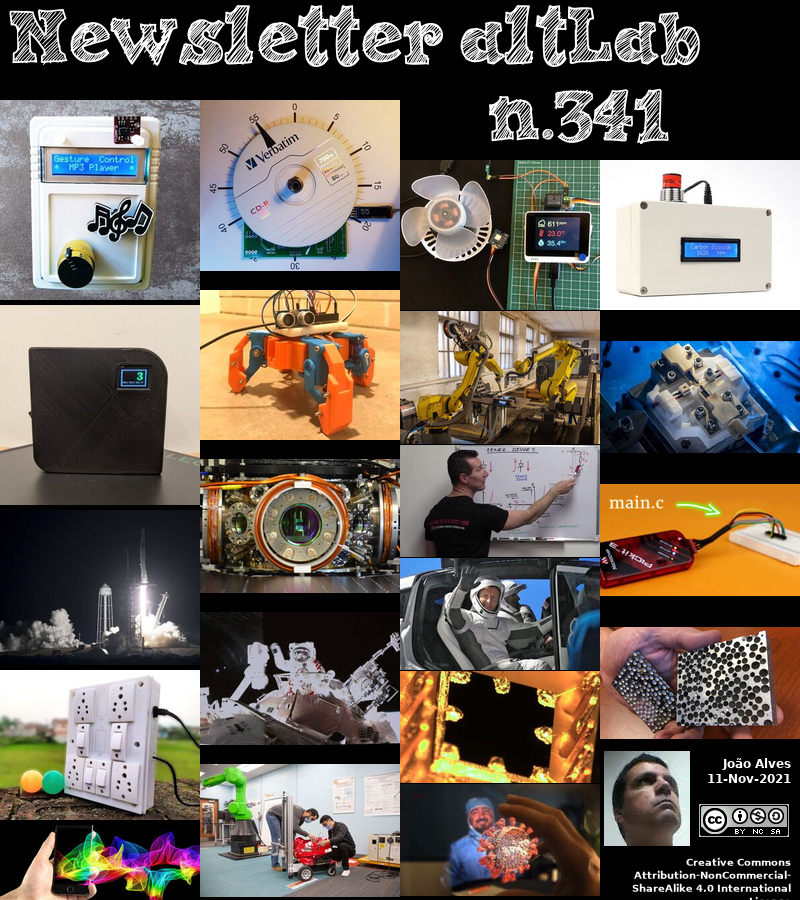2021-11-11 - Nº 341
Editorial
Esta é a Newsletter Nº 341 que se apresenta com o mesmo formato que as anteriores. Se gostar da Newsletter partilhe-a!
Todas as Newsletters encontram-se indexadas no link.
Esta Newsletter tem os seguintes tópicos:
Faz hoje anos que nascia, em 1904, o matemático britânico J. H. C. Whitehead. Ele influenciou grandemente o desenvolvimento da teoria da homotopia (um tipo especial de mapeamento de espaços topológicos). O trabalho de Whitehead em geometria diferencial culminou no artigo "On the Covering of a Complete Space by the Geodesics Through a Point" (1935), contendo contribuições pioneiras para esta área da matemática. Manteve sempre o seu interesse pela geometria, mas logo se concentrou na topologia. Fez contribuições substanciais para a homotopia combinatória e colectores Stiefel e fundou uma escola de topologia em Oxford.
Nesta semana que passou um lançamento da SpaceX marca o lançamento de 600 viajantes espaciais em 60 anos. Na passada quarta-feira, um foguetão da SpaceX transportou quatro astronautas em órbita. O voo repetidamente atrasado ocorreu apenas dois dias depois da SpaceX ter trazido quatro outros astronautas da Estação Espacial Internacional para casa. Eles deveriam ter lá estado para dar as boas-vindas aos recém-chegados, mas a NASA e a SpaceX decidiram mudar a ordem com base no tempo ideal de recuperação de segunda-feira no Golfo do México, e conseguiram-no.
Na Newsletter desta semana apresentamos diversas noticias, artigos científicos, projetos de maker assim como alguns videos interessantes.
 João Alves ([email protected])
João Alves ([email protected])
O conteúdo da Newsletter encontra-se sob a licença  Creative Commons Attribution-NonCommercial-ShareAlike 4.0 International License.
Creative Commons Attribution-NonCommercial-ShareAlike 4.0 International License.
Novidades da Semana

SpaceX crew launch marks 600 space travelers in 60 years
"A SpaceX rocket carried four astronauts into orbit Wednesday night, including the 600th person to reach space in 60 years. The repeatedly delayed flight occurred just two days after SpaceX brought four other astronauts home from the International Space Station. They should have been up there to welcome the newcomers, but NASA and SpaceX decided to switch the order based on Monday’s ideal recovery weather in the Gulf of Mexico and pulled it off. “It was a great ride, better than we imagined," mission commander Raja Chari said shortly after the spacecraft reached orbit. The launch was just as riveting for spectators at NASA's Kennedy Space Center, as well as along the East Coast, as the Falcon rocket thundered through clouds on its way to space, turning night into day. Germany’s Matthias Maurer claimed the No." [...]
Outras Notícias
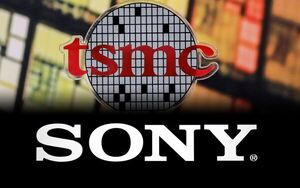
TSMC to Build Specialty Technology Fab in Japan with Sony Semiconductor Solutions as Minority Shareholder
"TSMC (TWSE: 2330, NYSE: TSM) and Sony Semiconductor Solutions Corporation (“SSS”) today jointly announced that TSMC will establish a subsidiary, Japan Advanced Semiconductor Manufacturing, Inc. (“JASM”), in Kumamoto, Japan to provide foundry service with initial technology of 22/28-nanometer processes to address strong global market demand for specialty technologies, with SSS participating as a minority shareholder. Construction of JASM’s fab in Japan is scheduled to begin in the 2022 calendar year with production targeted to begin by the end of 2024. The fab is expected to directly create about 1,500 high-tech professional jobs and to have a monthly production capacity of 45,000 12-inch wafers. The initial capital expenditure is estimated to be approximately US$7 billion with strong support from the Japanese government. Under definitive agreements reached between TSMC and SSS, SSS plans to make an equity investment in JASM of approximately US$0.5 billion, which will represent a less than 20% equity stake in JASM. The closing of the transaction between TSMC and SSS is subject to customary closing conditions." [...]

NASA’s SpaceX Crew-3 Astronauts Headed to International Space Station
"NASA’s SpaceX Crew-3 astronauts are in orbit following their launch to the International Space Station on the third commercial crew rotation mission aboard the microgravity laboratory. The international crew of astronauts lifted off at 9:03 p.m. EST Wednesday from Launch Complex 39A at NASA’s Kennedy Space Center in Florida. The SpaceX Falcon 9 rocket propelled the Crew Dragon Endurance spacecraft with NASA astronauts Raja Chari, Tom Marshburn, and Kayla Barron, as well as ESA (European Space Agency) astronaut Matthias Maurer, into orbit to begin a six-month science mission on the space station. This mission is the first spaceflight for astronauts Chari, Barron, and Maurer, and the third for Marshburn. Marshburn is the sixth person to launch from Earth on three different spacecraft. During Crew Dragon’s flight, SpaceX will monitor a series of automatic spacecraft maneuvers from its mission control center in Hawthorne, California, and NASA teams will monitor space station operations throughout the flight from the Mission Control Center at the agency’s Johnson Space Center in Houston." [...]

NXP’s i.MX 93 Applications Processor Family Powers a New Era of Secure Edge Intelligence
"NXP Semiconductors (NASDAQ: NXPI) today announced the i.MX 93 family of applications processors designed for automotive, smart home, smart building and smart factory applications, which leverage edge machine learning to anticipate and automate based on user needs. As the first applications processors in NXP’s i.MX 9 series, the new i.MX 93 family combines the industry’s first implementation of the Arm Ethos-U65 microNPU with state-of-the-art security and a high degree of integration to deliver efficient, fast, secure machine learning at the edge. These family attributes enable developers to address diverse areas, from voice-assisted smart home and building systems, to low-power industrial gateways and automotive driver monitoring systems. Systems that can process system inputs to make intelligent decisions locally with a high degree of accuracy are essential for the growth of the edge. To take on these challenges, the i.MX 93 family leverages a heterogenous multi-core architecture, including 1-2x Arm Cortex®-A55 applications processors running up to 1.7GHz and a real-time Cortex-M33 microcontroller sub-system with full access to all SoC peripherals, including the industry’s first implementation of a 256 MACs/cycle Arm Ethos-U65 microNPU. This architecture delivers best-in-class, power-efficient machine learning performance across a variety of applications, including compact, battery-powered IoT devices, which require highly capable and efficient processors to maintain a longer battery life." [...]

New Lattice sensAI Solution Stack Accelerates Next-Generation Client Devices
"Lattice Semiconductor Corporation (NASDAQ: LSCC), the low power programmable leader, today announced a roadmap of low power, AI/ML-enabled solutions that improve battery life and enable innovative user experiences in Edge applications such as Client Compute devices. Built with the award-winning Lattice sensAI™ solution stack and running on low power Lattice Nexus™ FPGAs, these new solutions will help OEMs develop smart, always-on devices with low power, hardware-accelerated AI capabilities that are field upgradeable to support future AI algorithms. Demand for more responsive and context-aware user experiences, high quality video conferencing, and collaboration applications on Client Compute devices is rising. Lattice Nexus FPGAs and the sensAI solution stack make a compelling platform for developing computer vision and sensor fusion applications that improve engagement, privacy, and collaboration for users. For example, a Client device can leverage image data from its camera to determine if someone is standing too close behind the user and blur the screen for privacy or lengthen battery life by dimming the device’s display when it “sees” the user’s attention is focused elsewhere. “AI applications based on vision, sound, and other sensors will revolutionize the Client Computing experience,” said Matt Dobrodziej, Vice President of Segment Marketing and Business Development at Lattice." [...]
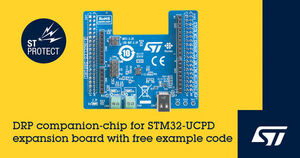
STMicroelectronics’ Port-Protection IC for STM32 MCUs Tailored to USB-C Dual-Role Power
"The STMicroelectronics TCPP03-M20 USB Type-C port-protection IC is tailored for Dual-Role Power (DRP) applications, simplifying the design of products that can act as a power source for connected devices as well as accepting power from other USB-C sources. When used as a companion chip with STM32G0*, STM32G4, STM32L5, and STM32U5 microcontrollers that contain ST’s UCPD (USB Type-C and Power Delivery) interface IP, the TCPP03-M20 enables a cost-effective partitioning of the USB Type-C implementation. Product designers can achieve a two-chip solution with the STM32 as the host microcontroller, saving bill-of-materials costs, PCB space, and circuit complexity. As defined in the USB Type-C specification, a USB-C dual Role devices, such as smart speaker, smartphone, tablet, laptop or camera have the ability to dynamically change their power role from sink to source as well as their USB data role from device to host (and vice-versa). This enables new use-cases to preserve and share energy between battery-powered devices, as well as to extend device interoperability. The USB DRP capability defined in the Type-C specification allows any USB devices with the ST chip inside to charge the battery of a connected device." [...]
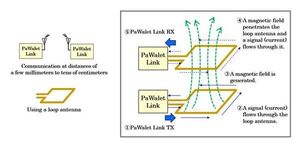
Panasonic Develops World's First Near Field Communication Technology Using Wavelet OFDM
"Panasonic Corporation today announced that it has developed a secure near field communication technology (hereinafter, "PaWalet Link") using a loop antenna by applying Wavelet OFDM*2 to a communication method using a magnetic field. As a result, it is possible to limit the communication range from a few millimeters to tens of centimeters. This technology can easily control the communication range by controlling the size of the loop antenna and the transmission power of the communication device. In addition, you can limit the frequency used by selecting the mode/channel. In the communication environment of the IoT/ DX / GX era, wireless technology will be used more and more in the future, and the number of connected terminals is expected to increase. As a result, interference among devices is regarded as a problem, and communication methods that can reduce interference are desired." [...]

Renesas Expands Lineup of 28nm Cross-Domain Automotive Control Microcontrollers
"Renesas Electronics Corporation, a premier supplier of advanced semiconductor solutions, today introduced a powerful new group of microcontrollers (MCUs), the RH850/U2B MCUs, designed to address the growing need to integrate multiple applications into a single chip and realize a unified electronic control unit (ECU) for the evolving electrical-electronic (E/E) architecture. Delivering a combination of high-performance, flexibility, freedom from interference, and security, the cross-domain RH850/U2B MCUs are built for the rigorous workloads required by vehicle motion in terms of hybrid ICE and xEV traction inverter, high-end zone control, connected gateway, and domain control applications. With this, Renesas expands its cross-domain MCU portfolio with devices that range from RH850/U2A MCUs for body and chassis control systems up to high-performance RH850/U2B MCUs. Customers can also combine these MCUs with Renesas’ R-Car S4 system-on-chip devices for automotive central gateway systems to build a scalable solution for E/E architectures. “The future of automotive systems design lies in a vehicle-centralized, zone-oriented E/E architecture, which elevates the need for automotive chips that address the challenges these innovative architecures create for future vehicle generations,” Naoki Yoshida, Vice President, Automotive Digital Products Marketing Division at Renesas. “The RH850/U2B MCUs expand Renesas’ cross-domain MCU family to offer customers higher levels of performance, memory integration, and hardware-based support for new zone- and domain-control applications, particularly for powertrain and HEV/EV, while maintaining the stringent cost, safety, and security parameters required for these automotive systems.” Designed for zone and domain applications, the 28nm RH850/U2B MCUs build on key functions from Renesas’ RH850/E2x Series for powertrain and RH850/C1M-Ax Series for HEV/EV motor control, while adding several new enhancements including new accelerator IP, higher performance levels, and increased security." [...]
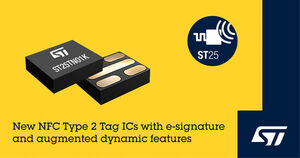
STMicroelectronics Launches Cost-Effective NFC Type 2 Tag IC with Privacy Features and Augmented NDEF
"STMicroelectronics’ ST25TN512 and ST25TN01K NFC Forum Type 2 tag ICs deliver a new balance of cost and performance for high-volume use cases like consumer engagement, product information, and brand protection. Also suitable for smart-city applications and access control, the ST25TN512/01K NFC tag ICs support multiple user-protection and privacy mechanisms including a 7-bit unique chip-identifier code, TruST25™ digital signature, NFC Forum T2T permanent write locks at block level, and a configurable kill mode that permanently deactivates the tag. Certified to NFC Forum Type 2 specifications, the ST25TN512 and ST25TN01K leverage ISO 14443 standards and can be used with NFC-compatible mobiles or a dedicated short-range reader. The embedded device memory includes up to 208 bytes (1664 bits) dedicated to user content. Support for messages in NFC Data Exchange Format (NDEF) allows triggering native actions on a smartphone without needing a dedicated app, such as launching a web browser or starting Bluetooth® pairing. Augmented NDEF (ANDEF) additionally enables reading dynamic information such as custom messages and unique tap codes without explicitly updating the EEPROM." [...]

Renesas Expands 5G mmWave Beamformer Portfolio with Industry-Leading Transmitter Output Power Capability
"Renesas Electronics Corporation (TSE:6723), a premier supplier of advanced semiconductor solutions, today expanded its 5G beamformer IC family with two new dual-polarization mmWave devices optimized for 2x2 antenna architecture for 5G and broadband wireless applications with best-in-class performance at n257, n258, and 261 bands. The highly integrated F5288 and F5268 transmitter/receiver (8T8R) chipsets sit on a small 5.1mm x 5.1mm BGA package and feature the industry’s highest Tx output power capability in silicon – delivering more than 15.5dBm linear output power (note 1) per channel. With this combination, Renesas enables cost-efficient radio design with extended signal reach for wireless infrastructure applications including wide-area, small cell and macro base stations, as well as CPE, fixed wireless access (FWA) access points, and various other applications. The new F5288 and F5268 ICs feature a unique Dynamic Array Power (DAP) technology that enables high-efficiency operation at linear output power levels programmable from 10 dBm up to 16 dBm. This makes the third-generation ICs ideal for use in mobile and fixed wireless applications with a wide range of output power requirements. This flexibility allows communications customers to reduce design times by repurposing their antenna array designs across different applications." [...]

Samsung Develops Industry’s First LPDDR5X DRAM
"Samsung’s LPDDR5X DRAM will provide over 1.3x faster processing speeds and consume nearly 20% less power than the previous LPDDR5 solution The LPDDR5X solution will broaden the use of high-performance, low-power memory beyond smartphones to AI and edge applications Samsung Electronics, the world leader in advanced memory technology, today announced that it has developed the industry’s first 14-nanometer (nm) based 16-gigabit (Gb) Low Power Double Data Rate 5X (LPDDR5X) DRAM, designed to drive further growth throughout the high-speed data service applications including 5G, artificial intelligence (AI) and the metaverse. “In recent years, hyperconnected market segments such as AI, augmented reality (AR) and the metaverse, which rely on extremely fast large-scale data processing, have been rapidly expanding,” said SangJoon Hwang, Senior Vice President and Head of the DRAM Design Team at Samsung Electronics. “Our LPDDR5X will broaden the use of high-performance, low-power memory beyond smartphones and bring new capabilities to AI-based edge applications like servers and even automobiles.” Samsung’s LPDDR5X is a next-generation mobile DRAM designed to significantly boost speed, capacity and power savings for future 5G applications. In 2018, Samsung delivered the industry’s first 8Gb LPDDR5 DRAM and today, the company is aggressively moving beyond mobile markets with the first 16Gb LPDDR5X DRAM. The LPDDR5X DRAM will offer data processing speeds of up to 8.5 gigabits per second (Gbps), which are over 1.3 times faster than LPDDR5’s 6.4Gbps. Leveraging the industry’s most advanced 14nm DRAM process technology, it will also use around 20% less power than LPDDR5 memory." [...]

Renesas Unveils New Multi-Cell Battery Front End Family for High-Cell Count, High-Voltage Systems
"Renesas Electronics Corporation (TSE:6723), a premier supplier of advanced semiconductor solutions, today introduced a new family of multi-cell full battery front end (BFE) ICs for battery management systems (BMS) built for the larger, high-voltage battery packs that power e-scooters, energy storage, high-voltage power tools, and other high-voltage equipment. The new ICs provide fast, flexible, cell balancing up to 200 mA+, a critical function to enable fast recharging and high utilization in large battery packs with hot plug tolerance up to 62V. “BMS serves as the “brains” of the battery pack, and the increasing adoption of BMS in UPS and the data center is spiking demand for high-performance ICs that can support higher voltage and larger cell battery pack sizes,” said Andrew Cowell, Vice President, Mobility, Infrastructure and IoT Power Business Division at Renesas. “BFEs are a critical part of BMS, and we’ve built our new RAA489206 and RAA489204 ICs with the performance, flexibility, and integration that make it easier than ever for customers to simplify the design process and create robust, cost-effective battery systems for the growing mobility, UPS backup, energy storage markets.” Designed for higher voltage mobility applications where larger cell count and temperature variance across cells are more likely to lead to cell-to-cell imbalances, the RAA489206 provides full high-side battery protection and monitoring for 4S to 16S cell battery packs. The RAA489204 provides improved daisy chain operation with accelerated device-to-device communication and enhanced diagnostics compared with previous-generation devices, as well as internal cell balancing options and support for the higher voltages and cell count required by UPS systems, grid backup, and other energy storage systems. The new ICs’ high integration simplifies the design cycle and reduces customers’ system BOM costs significantly, accelerating design and BOM selection time from months to weeks.The ICs also feature extensive built-in self diagnostics, improving their safety functionality, reducing firmware workload, and easing the design burden for meeting safety standards." [...]
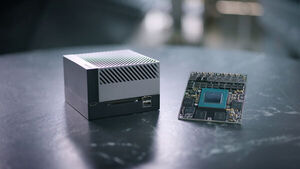
NVIDIA Sets Path for Future of Edge AI and Autonomous Machines With New Jetson AGX Orin Robotics Computer
"NVIDIA today introduced NVIDIA Jetson AGX Orin™, the world’s smallest, most powerful and energy-efficient AI supercomputer for robotics, autonomous machines, medical devices and other forms of embedded computing at the edge. Built on the NVIDIA Ampere architecture, Jetson AGX Orin provides 6x the processing power and maintains form factor and pin compatibility with its predecessor, Jetson AGX Xavier™. It delivers 200 trillion operations per second, similar to that of a GPU-enabled server but in a size that fits in the palm of your hand. The new Jetson computer accelerates the full NVIDIA AI software stack, allowing developers to deploy the largest, most complex models needed to solve edge AI and robotics challenges in natural language understanding, 3D perception, multisensor fusion and more. “As robotics and embedded computing transform manufacturing, healthcare, retail, transportation, smart cities and other essential sectors of the economy, the demand for processing continues to surge,” said Deepu Talla, vice president and general manager of embedded and edge computing at NVIDIA. “Jetson AGX Orin addresses this need, enabling the 850,000 Jetson developers and over 6,000 companies building commercial products on it to create and deploy autonomous machines and edge AI applications that once seemed impossible.” Jetson AGX Orin features an NVIDIA Ampere architecture GPU and Arm Cortex-A78AE CPUs, along with next-generation deep learning and vision accelerators." [...]

Nexperia expands its wide bandgap semiconductor offering with new family of high-performance Silicon Carbide (SiC) Diodes
"Nijmegen -- Samples of industrial-grade 650 V, 10 A SiC Schottky diode now available. Parts with 1200 V / 6-20 A current range and automotive-grade parts also planned Nexperia, the expert in essential semiconductors today announced its entry into the high-power Silicon Carbide (SiC) diodes market with the introduction of 650 V, 10 A SiC Schottky diodes. This is a strategic move for Nexperia, already a trusted supplier of efficient power Gallium Nitride (GaN) FETs, to expand its high-voltage wide bandgap semiconductor device offering. Nexperia’s first SiC Schottky diode is an industrial-grade device with 650 V repetitive peak reverse voltage (VRRM) and 10 A continuous forward current (IF), designed to combine ultra-high performance and high efficiency with low energy loss in power conversion applications. Providing the added benefit of a high-voltage compliant real 2-pin (R2P) package with higher creepage distance, it is available in a choice of surface mount (DPAK R2P and D2PAK R2P) or through-hole (TO-220-2, TO-247-2) devices. Engineering samples are available on request with a full product release planned for the second quarter of 2022." [...]

Chinese astronauts' EVAs to help extend mechanical arm
"The extravehicular activities (EVAs) carried out by two Chinese astronauts from Sunday evening till early Monday morning will help expand the capabilities of the mechanical arm on the country's space station, said the China Academy of Space Technology (CAST). Astronauts Zhai Zhigang and Wang Yaping were out of China's space station core module Tianhe by 8:28 p.m. (Beijing Time) Sunday, and completed their EVAs and returned to the space station core module Tianhe at 1:16 a.m. (Beijing Time) Monday. They performed a series of extravehicular tasks, including installing the dual-arm connector (the device linking the big and small mechanical arms) and the suspension device. The devices will help realize the connection of the big arm on the core module Tianhe and the small arm on the lab module Wentian, which is expected to be launched in 2022 to dock with Tianhe. The connected mechanical arms will be able to transfer a heavier load for a larger area range. According to Gao Sheng, an engineer in charge of the mechanical arm operation with the CAST, after connection, the big arm, 10 meters long, and the small arm, five meters long, will form a combined mechanical arm, with its operation range extended to 14.5 meters." [...]
Ciência e Tecnologia
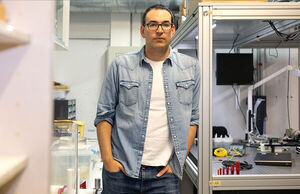
A highly sensitive optical thermometer suitable for industrial purposes is developed
"A study by the UPV/EHU-University of the Basque Country has produced an inert, optical thermometer capable of functioning in any hostile environment The UPV/EHU’s Applied Photonics Group has developed an optical thermometer for the industrial sector based on a very special optical fibre capable of measuring temperature across a wide thermal range with a high degree of sensitivity. Furthermore, the fibre is an inert component that does not interact with the environment. Temperature has always been a very important requirement in various industrial sectors. Certain industrial applications require a high degree of sensitivity as they are related to critical processes in which accurate, real-time temperature measurement is essential in preventing accidents, failures or breakdowns. In addition, the environments in which these measurements are made tend not to be favourable, so the devices are subjected to high levels of stress that can reduce their useful service life. Examples are the aviation industry where high temperatures inside turbines must be monitored; the petrochemical industry where flammable and explosive substances must be preserved within certain temperature ranges; the food industry where certain products must be stored at sub-zero temperatures, etc." [...]
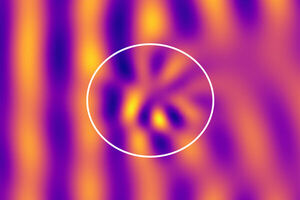
Radio-frequency wave scattering improves fusion simulations
"By incorporating the scattering of RF waves into fusion simulations, MIT physicists improve heating and current drive predictions for fusion plasmas. In the quest for fusion energy, understanding how radio-frequency (RF) waves travel (or “propagate”) in the turbulent interior of a fusion furnace is crucial to maintaining an efficient, continuously operating power plant. Transmitted by an antenna in the doughnut-shaped vacuum chamber common to magnetic confinement fusion devices called tokamaks, RF waves heat the plasma fuel and drive its current around the toroidal interior. The efficiency of this process can be affected by how the wave’s trajectory is altered (or “scattered”) by conditions within the chamber. Researchers have tried to study these RF processes using computer simulations to match the experimental conditions. A good match would validate the computer model, and raise confidence in using it to explore new physics and design future RF antennas that perform efficiently." [...]

Composite Metal Foam on Its Way to Influencing Market
"When mechanical and aerospace engineering professor Afsaneh Rabiei began developing composite metal foam, she looked to transform the transportation and military industries. Twenty years later, her product has the potential to save lives, and she wants to see it integrated in as many industries as possible. Composite metal foam (CMF) consists of metallic bubbles filled with air. These bubbles are then embedded within a metal matrix, like steel, aluminum or other metallic alloys. Because the finished product includes pockets of air, threats like heat, fire, impact, radiation and even blast and ballistics become weaker and less harmful. “I’m not in this work to become rich, buy a yacht and retire,” Rabiei said." [...]

Storing energy in plants with electronic roots
"By watering bean plants (Phaseolus vulgaris) with a solution that contains conjugated oligomers, researchers at the Laboratory of Organic Electronics, have shown that the roots of the plant become electrically conducting and can store energy. Dr Eleni Stavrinidou, associate professor and principal investigator in the Electronic Plants Group at the Laboratory of Organic Electronics, showed in 2015 that circuits can be fabricated in the vascular tissue of roses. The conducting polymer PEDOT was absorbed by the plant´s vascular system to form electrical conductors that were used to make transistors. In a later work in 2017, she demonstrated that a conjugated oligomer, ETE-S, could polymerise in the plant and form conductors that can be used to store energy. From plants cuttings to intact plants “We have previously worked with plants cuttings, which were able to take up and organise conducting polymers or oligomers. However, the plant cuttings can survive for only a few days, and the plant is not growing anymore." [...]

Can electric cars help strengthen electrical grids?
"Rochester researcher’s new model suggests ways to sell surplus energy from electric vehicles to local grids. American homeowners with solar panels can sell the surplus electricity they generate back to their local grids. Should electric vehicle (EV) owners be able to do the same thing? University of Rochester researchers show how so-called V2G (vehicle-to-grid) technology can achieve grid stability and renewable energy storage—and save vehicle owners potentially $120 to $150 a year—in a paper published in ACS Sustainable Chemical & Engineering. The idea is gaining traction in parts of Canada and Europe as a way to balance the increasing mismatch in electrical usage and generation that occurs as weather-dependent solar and wind energy sources come online. Renewable energy sources, even though they’re better for the planet, cannot replace traditional power because they aren’t always available." [...]

New Sensor Detects Ever Smaller Nanoparticles
"Nanoparticles are omnipresent in our environment: Viruses in ambient air, proteins in the body, as building blocks of new materials for electronics, or in surface coatings. Visualizing these smallest particles is a problem: They are so small that they can hardly be seen under an optical microscope. Researchers of Karlsruhe Institute of Technology (KIT) have now developed a sensor that not only detects nanoparticles, but also determines their condition and tracks their movements in space. The highly sensitive and compact detector, a novel type of Fabry-Pérot resonator, is presented in Nature Communications (DOI: 10.1038/s41467-021-26719-5). Conventional microscopes produce enlarged images of small structures or objects with the help of light. Nanoparticles, however, are so small that they hardly absorb or scatter light and, hence, remain invisible." [...]
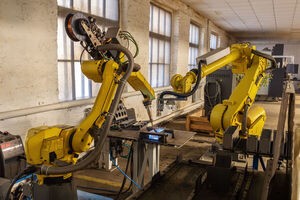
Giving robots social skills
"A new machine-learning system helps robots understand and perform certain social interactions. Robots can deliver food on a college campus and hit a hole-in-one on the golf course, but even the most sophisticated robot can’t perform basic social interactions that are critical to everyday human life. MIT researchers have now incorporated certain social interactions into a framework for robotics, enabling machines to understand what it means to help or hinder one another, and to learn to perform these social behaviors on their own. In a simulated environment, a robot watches its companion, guesses what task it wants to accomplish, and then helps or hinders this other robot based on its own goals. The researchers also showed that their model creates realistic and predictable social interactions. When they showed videos of these simulated robots interacting with one another to humans, the human viewers mostly agreed with the model about what type of social behavior was occurring." [...]

Energy Storage: Modular System Enhances Flexibility
"The main idea of the LeMoStore project is to flexibly combine different energy storage technologies and to connect battery modules to the power grid via a grid-compatible inverter. For this purpose, Karlsruhe Institute of Technology (KIT) collaborates with partners from science and industry. LeMoStore aims to achieve a maximum service life of battery modules and stable power supply with a high share of renewable energy sources. LeMoStore is funded by the Federal Ministry for Economic Affairs with about EUR 1.7 million. The share of renewable energy sources in the power supply mix is increasing. As solar and wind power fluctuate as a function of time and weather, powerful energy storage systems are required in the public grid to ensure stable supply." [...]
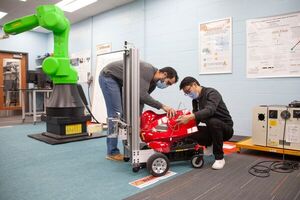
This UC robot doesn't need to knock
"One flaw in the notion that robots will take over the world is that the world is full of doors. And doors are kryptonite to robots, said Ou Ma, an aerospace engineering professor at the University of Cincinnati. “Robots can do many things, but if you want one to open a door by itself and go through the doorway, that’s a tremendous challenge,” Ma said. Students in UC’s Intelligent Robotics and Autonomous Systems Laboratory have solved this complex problem in three-dimensional digital simulations. Now they’re building an autonomous robot that not only can open its own doors but also can find the nearest electric wall outlet to recharge without human assistance. This simple advance in independence represents a huge leap forward for helper robots that vacuum and disinfect office buildings, airports and hospitals." [...]
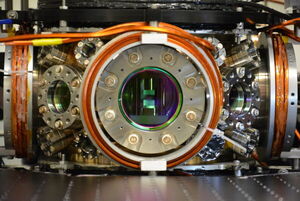
Stanford researchers develop a quantum simulator that exhibits the building blocks of sound
"Aiming to emulate the quantum characteristics of materials more realistically, researchers have figured out a way to create a lattice of light and atoms that can vibrate – bringing sound to an otherwise silent experiment. When sound was first incorporated into movies in the 1920s, it opened up new possibilities for filmmakers such as music and spoken dialogue. Physicists may be on the verge of a similar revolution, thanks to a new device developed at Stanford University that promises to bring an audio dimension to previously silent quantum science experiments. In particular, it could bring sound to a common quantum science setup known as an optical lattice, which uses a crisscrossing mesh of laser beams to arrange atoms in an orderly manner resembling a crystal. This tool is commonly used to study the fundamental characteristics of solids and other phases of matter that have repeating geometries. A shortcoming of these lattices, however, is that they are silent." [...]
Simple silicon coating solves long-standing optical challenge
"New approach expands the application of powerful, ultrafast laser pulses. Quick bursts of laser light, lasting less than a trillionth of a second, are used in a range of applications today. These ultrashort laser pulses have allowed scientists to observe chemical reactions in real-time, image delicate biological samples, build precise nanostructures, and send long-distance, high-bitrate optical communications. But any application of ultrashort laser pulses in the visible spectrum must overcome a fundamental difficulty — red light travels faster than blue light through transparent materials like glass. So, when an ultrashort laser pulse passes through a glass lens, the tightly packed wavelengths of light separate, destroying the usefulness of the beam. This chromatic dispersion problem has plagued optical researchers for decades." [...]
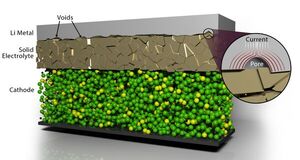
New scalable method resolves materials joining in solid-state batteries
"Scientists at the Department of Energy’s Oak Ridge National Laboratory have developed a scalable, low-cost method to improve the joining of materials in solid-state batteries, resolving one of the big challenges in the commercial development of safe, long-lived energy storage systems. Solid-state batteries incorporate a safer, fast-charging architecture featuring a solid-state electrolyte versus the liquid electrolytes in today’s lithium-ion batteries. A successful solid-state commercial battery system could provide at least two times the energy density of lithium-ion batteries in a much smaller footprint. The system would enable electric vehicles with vastly improved driving range, for instance. One of the challenges in manufacturing solid-state batteries is the difficulty of getting materials to properly join and remain stable during repeated cycles of charging and discharging. Scientists studying methods in a lab to overcome this characteristic, called contact impedance, have so far focused on applying high pressures and other methods." [...]

Time crystals in the limelight
"UC Berkeley physicist Norman Yao first described five years ago how to make a time crystal — a new form of matter whose patterns repeat in time instead of space. Unlike crystals of emerald or ruby, however, those time crystals existed for only a fraction of a second. But the time has arrived for time crystals. Since Yao’s original proposal, new insights have led to the discovery that time crystals come in many different forms, each stabilized by its own distinct mechanism. Using new quantum computing architectures, several labs have come close to creating a many-body localized version of a time crystal, which uses disorder to keep periodically-driven quantum qubits in a continual state of subharmonic jiggling — the qubits oscillate, but only every other period of the drive. In a paper published in the journal Science last week, Yao and colleagues at QuTech — a collaboration between Delft University of Technology and TNO, an independent research group in the Netherlands — reported the creation of a many-body localized discrete time crystal that lasted for about eight seconds, corresponding to 800 oscillation periods." [...]

3D printing nanoresonators: towards miniaturized and multifunctional sensors
"Micro-electro-mechanical devices (MEMS) are based on the integration of mechanical and electrical components on a micrometer scale. We all use it continuously in our everyday life: for example in our mobile phone there are at least a dozen MEMS that regulate different activities ranging from motion, position and inclination monitoring of the phone, active filters for the different transmission bands and the microphone itself. Even more interesting is the extreme nanoscale miniaturization of these devices (NEMS), because it offers the possibility of creating inertial, mass and force sensors with such sensitivity that they can interact with single molecules. However, the diffusion of NEMS sensors is still limited by the high manufacturing cost of traditional silicon-based technologies. Conversely, new technologies such as 3D printing have shown that similar structures can be created at low cost and with interesting intrinsic functionalities, but to date the performance as mass sensors are poor. The article "Reaching silicon-based NEMS performances with 3D printer nanomechanical resonators" published in the prestigious journal Nature Communications shows how it is possible to obtain mechanical nanoresonators from 3D printing with figures of merit such as quality factor, published stability, mass sensitivity and strength comparable to those of silicon resonators." [...]
A superconducting silicon-photonic chip for quantum communication
"Researchers resolve a long-standing challenge in quantum optics: optimal Bell-state measurement of time-bin encoded qubits, to enhance the key rate of secure quantum communication Integrated quantum photonics (IQP) is a promising platform for realizing scalable and practical quantum information processing. Up to now, most of the demonstrations with IQP focus on improving the stability, quality, and complexity of experiments for traditional platforms based on bulk and fiber optical elements. A more demanding question is: "Are there experiments possible with IQP that are impossible with traditional technology?" This question is answered affirmatively by a team led jointly by Xiao-Song Ma and Labao Zhang from Nanjing University, and Xinlun Cai from Sun Yat-sen University, China. As reported in Advanced Photonics, the team realizes quantum communication using a chip based on silicon photonics with a superconducting nanowire single-photon detector (SNSPD). The excellent performance of this chip allows them to realize optimal time-bin Bell state measurement and to significantly enhance the key rate in quantum communication." [...]

Surrey researchers reveal the hidden behaviour of supercapacitor materials
"Researchers from the University of Surrey’s Advanced Technology Institute (ATI) and the University of São Paulo have developed a new analysis technique that will help scientists improve renewable energy storage by making better supercapacitors. The team’s new approach enables researchers to investigate the complex inter-connected behaviour of supercapacitor electrodes made from layers of different materials. Improvements in energy storage are vital if countries are to deliver carbon reduction targets. The inherent unpredictability of energy from solar and wind means effective storage is required to ensure consistency in supply, and supercapacitors are seen as an important part of the solution. Supercapacitors could also be the answer to charging electric vehicles much faster than is possible using lithium-ion batteries. However, more supercapacitor development is needed to enable them to effectively store enough electricity." [...]
Ultra-pure semiconductor opens new frontier in the study of electrons
"Princeton researchers have created the world's purest sample of gallium arsenide, a semiconductor used in devices that power such technologies as cell phones and satellites. The team baked their material down to one impurity for every 10 billion atoms, reaching a level of quality that outstrips even the world's purest silicon sample used in verifying the one-kilogram standard. The finished gallium arsenide chip, a square about the width of a pencil eraser, allowed the team to probe deep into the very nature of electrons. Rather than sending this chip to space, the researchers took their ultra-pure sample to the basement of Princeton's engineering quadrangle where they wired it up, froze it to colder-than-space temperatures, enveloped it in a powerful magnetic field and applied a voltage, sending electrons through the two-dimensional plane sandwiched between the material's crystalline layers. As they lowered the magnetic field, they found a surprising series of effects. The results, published(link is external) in Nature Materials, showed that many of the phenomena driving today's most advanced physics can be observed under far weaker magnetic fields than previously thought." [...]

Creating an artificial material that can sense, adapt to its environment
"Move over, Hollywood — science fiction is getting ready to leap off the big screen and enter the real world. While recent science fiction movies have demonstrated the power of artificially intelligent computer programs, such as the fictional character J.A.R.V.I.S. in the Avenger film series, to make independent decisions to carry out a set of actions, these imagined movie scenarios could now be closer to becoming a reality. In a recent study published in Nature Communications, a journal of Nature, researchers at the University of Missouri and University of Chicago have developed an artificial material, called a metamaterial, which can respond to its environment, independently make a decision, and perform an action not directed by a human being. For example, a drone making a delivery might evaluate its environment including wind direction, speed or wildlife, and automatically change course in order to complete the delivery safely. In a recent study published in Nature Communications, a journal of Nature, researchers at the University of Missouri and University of Chicago have developed an artificial material, called a metamaterial, which can respond to its environment, independently make a decision, and perform an action not directed by a human being." [...]
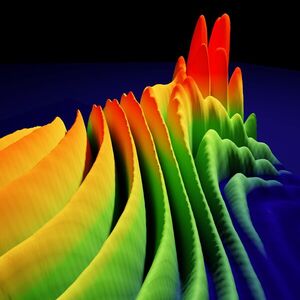
Separated only by quadrillionths of a second: Ultrashort flashes of light combined precisely and quickly
"Ultrashort flashes of light lasting less than a quadrillionth of a second are fast growing in technological importance. In laser sources, pairs and groups of light flashes can be created instead of individual flashes. Similar to the chemically bonded atoms in a molecule, they are coupled with each other and their short temporal intervals can possess remarkable stability. Researchers at the Universities of Bayreuth and Constance have now revealed a cause for the stable coupling of ultrashort light flashes and found a way to control their spacing both very precisely and rapidly. They present their research results in the journal "Optica". Light flashes shorter than a quadrillionth of a second are also called femtosecond pulses. Today, they are used for researching energy materials, in the 3D manufacturing of components, or as precision scalpels in medicine." [...]

Achieving razor-sharp vision in the metaverse
"Thanks to the enhanced light-field technology developed by EPFL spin-off Creal, augmented-reality and virtual-reality images appear increasingly life-like with less strain on users’ eyes. The company will present the latest version of its system at the Augmented World Expo this week in California. Augmented reality and virtual reality could one day be part of our everyday lives, whether we’re buying groceries, attending a meeting, playing a video game or even undergoing surgery. Some tech enthusiasts believe that many of our day-to-day interactions could soon take place in the metaverse – an alternate world where people move seamlessly between the virtual and physical realms. But before that can happen, many improvements need to be made to AR and VR systems, such as to improve touch and smell capabilities, streamline the interfaces with virtual elements, and display more life-like images. It’s this last challenge that Creal’s founders decided to address with their new generation of light-field technology." [...]

Synthesizing Nanomaterials from Nature’s Blueprints
"Molecular self-assembly expert Chun-Long Chen describes the challenges and opportunities ahead in bio-inspired materials design Velcro. Airplanes. Sonar. What do these have in common? The invention of each was inspired by nature. Velcro mimics burdock burr’s ability to attach to clothing." [...]
Projetos Maker
Diversos Projetos interessantes.
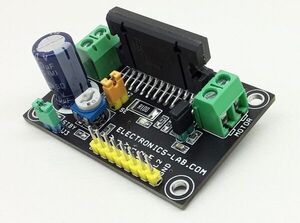
8A Brushed DC Motor Driver with Adjustable Constant Current, Direction Control, Brake Control, Speed Control
"This is a very powerful brushed DC motor drive system in a small package with a few key features like adjustable constant current control, direction control, brake controls, Alert output, PWM for speed control etc. The project was built using a TB67H303HG chip which is a full-bridge driver IC for DC motor adopting MOS at output transistors. High-power and high-efficient drive are possible by adopting DMOS output driver with low-ON resistance and PWM drive. Refer to the datasheet of TB67H303HG for more information. " [...]
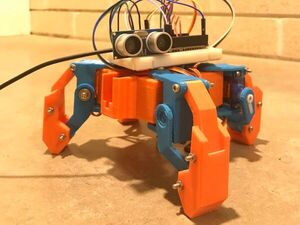
Bubba - The quadrupedal spider robot
"Bubba is a 3D printed quadrupedal spider robot. It has 8 degrees of freedom and can operate both autonomously and programmatically. Inspiration for the project: Bubba is a project I embarked on to combine my love for mechantronics, motion planning algorithms and robotics (and Forrest Gump, hence the name!). During the COVID-19 lock down, I got interested in biologically-inspired robots and their unique motion style. Taking ENGI 301 this semester at Rice University and learning about embedded systems gave me the confidence to embark on my journey into building a biologically inspired robot. Since I am terrified of spiders, I thought it would be a good idea to build a spider robot." [...]
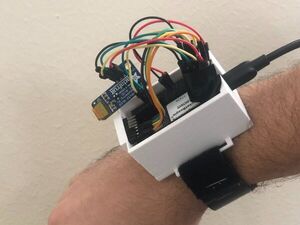
No Touch Gesture Calculator
"This bracelet enables you to do basic calculations on the spot by simply gesturing what you want in the air. Story I work in a research lab and taking my gloves off just to do some basic arithmetic on my phone has always seemed very inefficient and kind of annoying to do, since once you take gloves off it's a nightmare to put them back on immediately afterward. Therefore, I designed this gesture calculator that allows me to do all those basic calculations without having to take my gloves off or worry about contaminating my phone. I've also wanted to dive into tinyML for a while now, so this felt like an appropriate project on which to implement my first TFLite project on the PocketBeagle. Build Instructions From a hardware point of view, this project is pretty simple, all you need is the PocketBeagle, the MPU6050 IMU, and the OLED Screen. Since the PocketBeagle might be an unfamiliar platform for some of you, I am attaching the pin diagram of it here." [...]
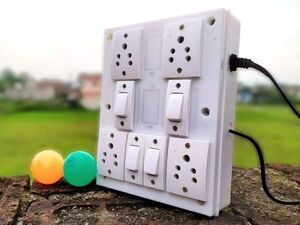
Smart Extension Board
"Arduino based Smart Bluetooth Controlled Extension Board A home automation system typically connects controlled devices to a central smart home hub. The user interface for control of the system uses a mobile phone application. Bluetooth Controlled Electronic Home Appliances is a simple project, where we can control different electrical appliances and electronic devices using an Android device with the help of Bluetooth Technology By following this guide, you will be able to know and make your smart extension board. This project guide contains the files necessary to help you step by step produce your own Smart Extension Board. Please follow the steps of the project to get a positive result. Users should install an Android application in the user’s mobile to control the electrical loads." [...]
Bicycle Journey Tracker With Arduino and GPS Module
"This is a bicycle journey recording device utilizing Arduino and a GPS module. Im riding an electrical bicycle from time to time during weekends. Several good bicycle riding routes which pass by the lakes and parks are located near to my house. Therefore, bicycle riding become a favorite personal pastime recently. For planning the next journey, checking previous riding history becomes very useful and important. When GPS-based detail route information is available, a more customized and well-organized next bicycle riding journey plan can be made." [...]
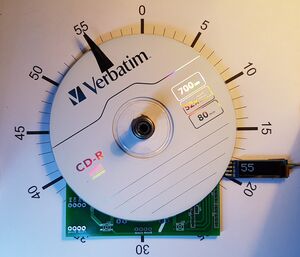
Absolute Position Encoder With Single Track Gray Code
"I made a rotary encoder. Due to its 60 steps (6 degree) resolution it suits to make clocks. There is a very good and detailed description of the single track Gray code here: https://www.ncbi.nlm.nih.gov/pmc/articles/PMC6111776/. My instructable is only about physical realization now. " [...]

Portable Air Quality Sensor
"Building an AQI sensor with off-the-shelf parts and 3D-printed case After visiting Seattle this summer during the forest fires and being made aware of how important AQI is, I decided to build my own AQI device. When going into this project, I was not 100% sure what I wanted, but after a few iterations of hardware combinations, I came to the following requirements: 1. Portable 2. Off-the-shelf components 3. 3D-printable case 4. Fast start time Bill of material: Adafruit Feather RP2040 (https://www.adafruit.com/product/4884) PMS5003 PM2.5 Air Quality Sensor (https://www.adafruit.com/product/3686) Lithium Battery (https://www.adafruit.com/product/1781) Adafruit Powerboost 1000 Charger (https://www.adafruit.com/product/2465) 0.96" OLED Display (https://www.amazon.com/HiLetgo-Colorful-Display-SSD1331-Resolution/dp/B0711RKXB5) On/Off Switch Power Rail (snapped an end of a breadboard) Jumper Wires M2 Screws Wiring: PM2.5 TX to RP2040 RX PM2.5 5V/Gnd to Power Rail OLED SPI to RP2040 SPI OLED 5V/Gnd to Power Rail RP2040 Gnd to Power Rail Gnd RP2040 USB to Power Rail 5V PowerBoost 5V/Gnd to Power Rail PowerBoost En/Gnd to Switch Journey: To start the project, I ordered a few parts, such as the PM2.5 sensor, battery and RP2040, while reusing a bunch of other parts I had laying around from other projects." [...]
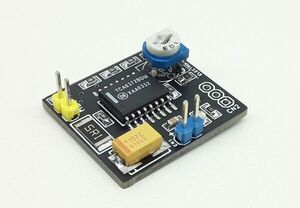
Bidirectional Speed Control for DC Motors
"This is a very simple bidirectional speed control of a small DC brushed motor. The project is built using power OPAMP TCA0372 which can drive a load up to 1A. Connecting a small DC motor and trimmer pot will control the motor forward/reverse operation along with speed control. A Trimmer potentiometer is provided to set the speed and direction of the motor. The motor is stopped when the potentiometer is in the center, turn the pot clockwise to run the motor in the forwarding direction, turning the pot counterclockwise will run the motor in the reverse direction. Operating power supply 12V DC." [...]
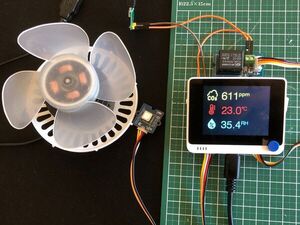
CO2 levels monitoring and Airflow control using Wio Terminal
"This device monitors CO2 level in the living or bedroom and controls a ventilation fan to improve airflow. Carbon dioxide (CO2) is the fourth most abundant gas in the earth's atmosphere. CO2 is a byproduct of normal cell function when it is breathed out of the body. It is also produced when fossil fuels are burned or decaying vegetation. Surface soils can sometimes contain high concentrations of this gas, from decaying vegetation or chemical changes in the bedrock. We measure the CO2 level in ppm units." [...]

Gesture Controlled MP3Player
"Control your MP3Player with hand Gestures In this project i use gesture sensor to read and interpret hand movements as commands to control an MP3 Player. Gesture recognition is a topic in computer science and language technology with the goal of interpreting human gestures via mathematical algorithms. Gestures can originate from any bodily motion or state but commonly originate from the face or hand. Users can use simple gestures to control or interact with devices without physically touching them. I used PAJ7620U2 Gesture Sensor. PAJ7620U2 Gesture Sensor, gesture recognition function with general I2C interface into a single chip." [...]
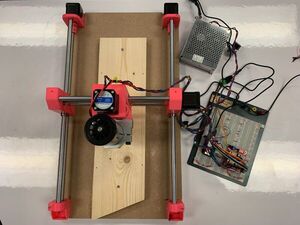
PocketBeagle CNC Using BeagleG
"An implementation of Nikodem Bartnik's 3D printed dremel CNC with a 500W spindle and a PocketBeagle. This semester I decided to pursue the idea of building a desktop CNC router using BeagleBoard's PocketBeagle as the gcode processing unit. My intial attempt was to use MachineKit, a fork of LinuxCNC, as my gcode processing software, but after exploring the option for a while I determined that it was no longer supported to the extent that I would need to complete the project. I was able to successfully implement BeagleG, a gcode interpreter built by GitHub user Henner Zeller. The Process: Mechanical- I started the project with the mechanical side. After ordering the variety of linear motion guides and lead screws, I started printing the necessary PLA fixtures." [...]
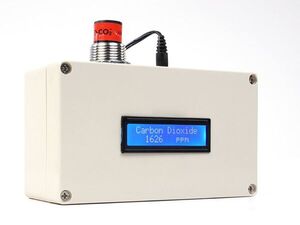
Arduino CO2 Meter
"How to make a benchtop CO2 meter. In this project, we will be making a benchtop-style CO2 meter using the sensor from Atlas Scientific hooked up to an Arduino Uno. The real-time readings in PPM will be shown on a liquid crystal display (LCD). Both the sensor and display are connected to the Arduino via I2C. Note: This device was developed and tested using a Windows computer. It was not tested on Mac." [...]
Secção Videos
Videos interessantes.
That's all Folks!



